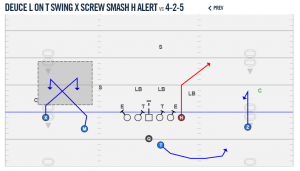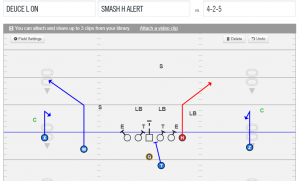In coaching, the worst case scenario is always losing your stud athlete early in the season. What can the Packers do to stay alive in the playoff race?
Aaron Rodgers is out. While most of the Packers’ fanbase spent this week in an apprehensive shock, it’s full steam ahead at 841 Armed Forces Drive. The Packer coaching staff will be bustling to prepare backup Brett Hundley for this week’s tilt versus the New Orleans Saints. Here’s a prospective look at what this week’s task entails.
K.I.S.S. (Keep It Simple, Stupid)
This acronym was pounded into my brain early and often in communication courses in college, and it most certainly applies here. Coaches and support staff routinely mention “shrinking the playbook” when referencing new or inexperienced players, but it does not necessarily mean removing whole plays. Rather, the playcall(s) can be adapted to the specific player’s skillset. Here is a hypothetical example of a playcall that Rodgers would get from the sidelines, tailored to his vast knowledge and comforts:
“Deuce Left On, T Swing, X Screw, Smash H Alert, Llama Llama on One.”
That chaotic mass of consonants and jumbled syllables translates to this play:
There’s a lot going on here:
“Deuce Left On” is the formation.
“T Swing” is the option route by the tailback.
“X Screw” is the window route concept on the left (We’ll address window routes later)
“Smash H Alert” is the trigger route concept on the right. (H Alert means look at H. Likely open)
“Llama Llama” is the line protection- Lock scheme
This playcall is lethal with a player of Rodgers’ caliber because of the conflict it can put a defense in. The Packers will now simply modify the call to a more modest version of the same play, but with mirrored concepts and no tailback route. Not as dynamic, but easier to execute at the speed the Packers would like. Example:
“Deuce Left On, Smash H Alert, Llama Llama”
A much cleaner version of the same play that will allow Hundley to play fast (not to mention the added benefit of a running back in pass protection).
Look for Green Bay to modify most of their playcalls to mirrored versions in an effort to reduce turnovers and speed up reads for their young QB.
“Windows” vs “Triggers”
In the first play above, we can see a shaded box on the left and a green “C” (for cornerback) on the right. These distinguish two separate reads for a QB. A window read indicates that eventually an opening or window will appear in the coverage, and the QB never actually reads a defender. The ball must be thrown with great accuracy and timing to fit the window, but if it is executed correctly it is virtually indefensible. The green “C” represents a trigger read in which the QB will read a defender. In this specific play, should the corner bail deep at the snap, QB will throw the hitch to Z. If the corner stays on the hitch, QB will toss the deep corner route to H.
In summation: Window reads are fatal to defenses, because they are present on almost every play. But they are very risky- it takes an incredible quarterback to hit them consistently. Trigger reads are safer, but limited. Defenses have ways to scheme them out at times. I suspect Green Bay will adapt many of their former window reads into trigger concepts to help Hundley out.
Release Point
Oh, young Hundley. Let’s fix this. Quickly. In breaking down the Viking game, I noticed Hundley (perhaps from anxiety, perhaps from mechanics) release the ball at the very top of his arm extension with very little follow through. This allowed to ball to float dangerously on a few missed targets.
Rule One for throwing the ball: If you’re gonna miss, you better miss low.
Sailing a ball high in the NFL can only result in two things- a plethora of turnovers and a quick benching. I’m sure the Packers’ exceptional coaches have many ways of correcting this. I do not. I honestly just tell my quarterbacks to hit the hip of their receiver, so that even if they do miss it’s still somewhat in the receiver’s catch radius. I defer to the experts on this one (after all, they do make waaay more money than me).
Five And A Slide
I may get fired for writing this, but I honestly think the quarterback is the most underused position in the NFL. Because of most quarterbacks’ unwillingness to advance the ball with their feet, defenses get the feeling that they’re facing 10 players with their 11. A great way to jumpstart a young QB’s confidence is to give them the green light to run, especially if using trigger reads (see above).
Don’t like the read you just got from the corner? Safety jumping the top? Backside pressure?
TUCK AND GO!
The imminent drawback to this, obviously, is exposing your quarterback to big hits in the open field. The coaching point I use to get around this is “Five and a Slide”. Get us five yards, especially on early downs, and slide well before you think you need to. I’ll always live with 3rd and 5 as opposed to a turnover or, worse, scrambling to prepare another signalcaller.
What do you think? Did Coach Hawn miss any big adjustments? What would you do? Leave your comments below!

